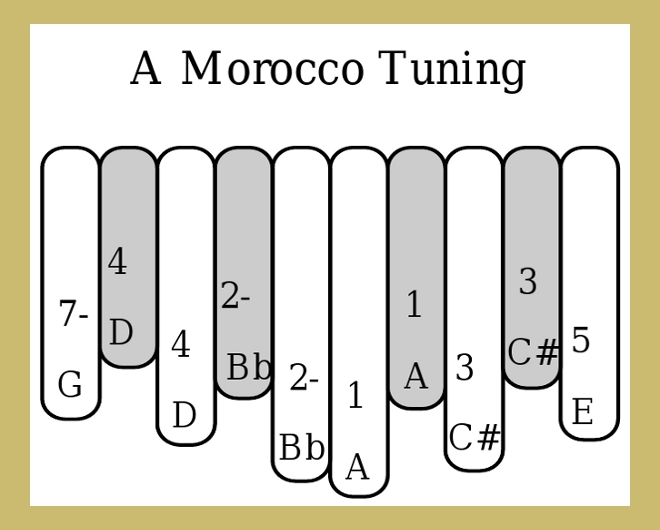
Use of this website constitutes acceptance of the Privacy Policy and User Agreement. Copyright © 2020 Kalimba Magic. All Rights Reserved.
Several customers have been asking me for a Middle Eastern tuning for the Moon-10 Kalimba. The result is the “Morocco A” tuning, “A Middle Eastern” tuning, or the “Desert Moon”. And I must admit, the result is magical. Watch the video to check for yourself!
“A Middle Eastern” or “A Morocco” Tuning for the Moon-10
This is a 6-note Middle Eastern scale (A=1, Bb=2-, C#=3, D=4, E=5, G=7-). (If you are not up on the notation: 1, 2, 3 are the “degrees of the major scale”. “3” is the major 3rd. “2-” is a flat 2nd, just a half step above the root note or “1”. “7-” is a flat 7th.)
On a kalimba with alternating note layout: diatonic scales (with 7 notes per octave) and pentatonic scales (with 5 notes per octave) both switch sides for upper octaves. If a particular note is on one side of the kalimba, the upper octave version of that note will be on the opposite side of the kalimba. With 6 notes per octave, this means the upper octave notes will be on the same side as the lower octave versions of those notes.
 Check out the tuning chart here: on the right side, the long “A” is right next to the upper octave “A”, the lower and upper C# tines are right next to each other. On the left side, the two Bb tines are adjacent to each other, and the two D tines are adjacent to each other.
Check out the tuning chart here: on the right side, the long “A” is right next to the upper octave “A”, the lower and upper C# tines are right next to each other. On the left side, the two Bb tines are adjacent to each other, and the two D tines are adjacent to each other.
In fact, the entire right side makes the A major chord (A C# E). The entire left side makes the G minor major chord (G Bb D).
Very important: the “2-” indicates a “flat second” – the Bb is a half step above the A, and this is what gives this scale it’s Middle Eastern feeling.
Two important playing techniques for this tuning are: the pull off, and the cross over.
If you are playing either the A or C# on the upper right side, you can pull off to adjacent lower tines in either direction. These will all sound very good. Similarly, when playing the Bb or D on the upper left side, you can pull off and strike any of the lower row tines on the left, and they will all make nice harmonizing sounds.
The cross over technique is when one thumb reaches over and played notes on the opposite side of the kalimba. The fact that the five right side notes are all in the A major chord indicates why you might want to cross over with the left thumb. Both right and left thumbs can play the right side notes to make a complex arpeggio from the notes of the A major chord. Similarly, the right thumb could cross over and help the left thumb play the notes of the Bb chord.
If you have a Moon-10 Kalimba already, you can retune it yourself, according to the tuning diagram. If you don’t have a Moon-10, you can order a Moon-10, specifying the A Middle Eastern tuning. For the month of May 2021, you can save 25% on the Moon-10 kalimba in any of its great tunings with the coupon code Moon25.
Playing Kalimba With One Hand? Try the Moon-10 in Golden or Silver Moon Tuning


Sign up for our newsletter and free resources with your email address:
We pinky promise not to spam you and to only send good stuff.
 Assist Paul Tracey Rebuild His House in Pacific Palisades
Assist Paul Tracey Rebuild His House in Pacific Palisades 8-Note Spiral Kalimba Turned into a Student Karimba
8-Note Spiral Kalimba Turned into a Student Karimba Seek to Infuse Your Musical Moments With Beauty and Magic
Seek to Infuse Your Musical Moments With Beauty and MagicUse of this website constitutes acceptance of the Privacy Policy and User Agreement. Copyright © 2020 Kalimba Magic. All Rights Reserved.